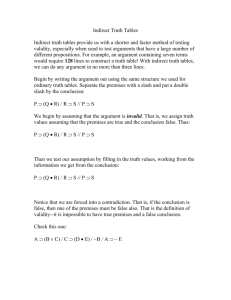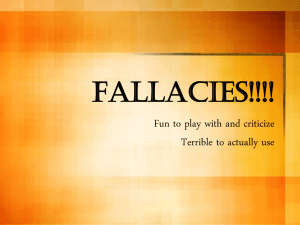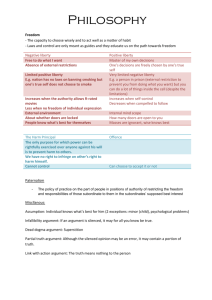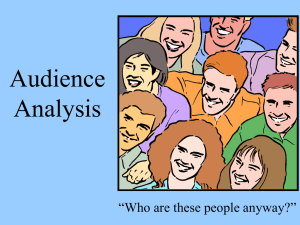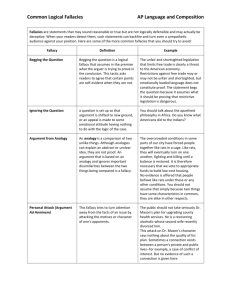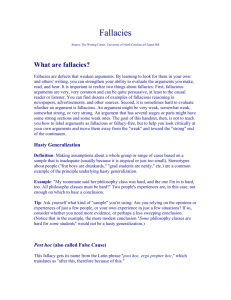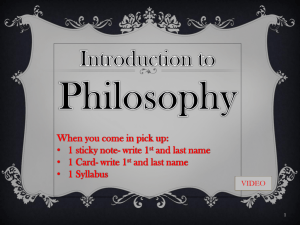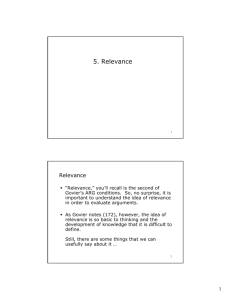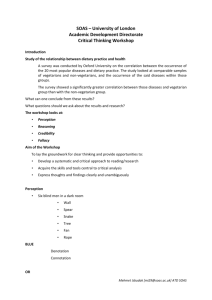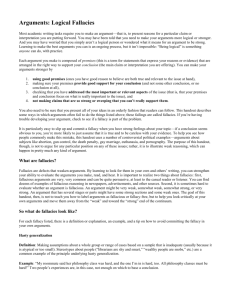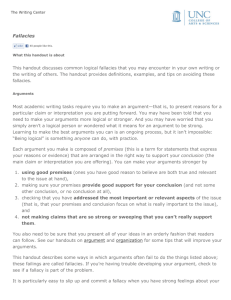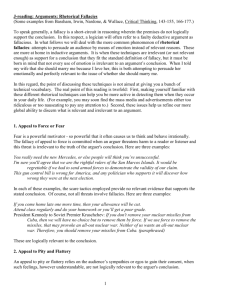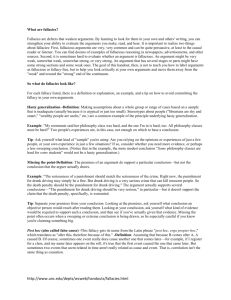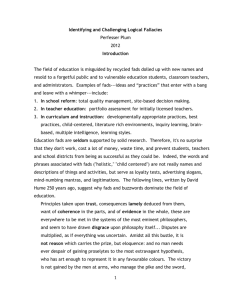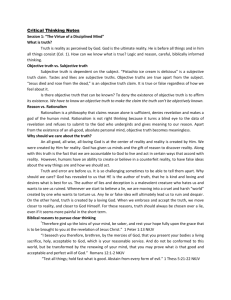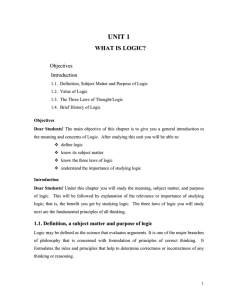Making a Solid Argument
advertisement
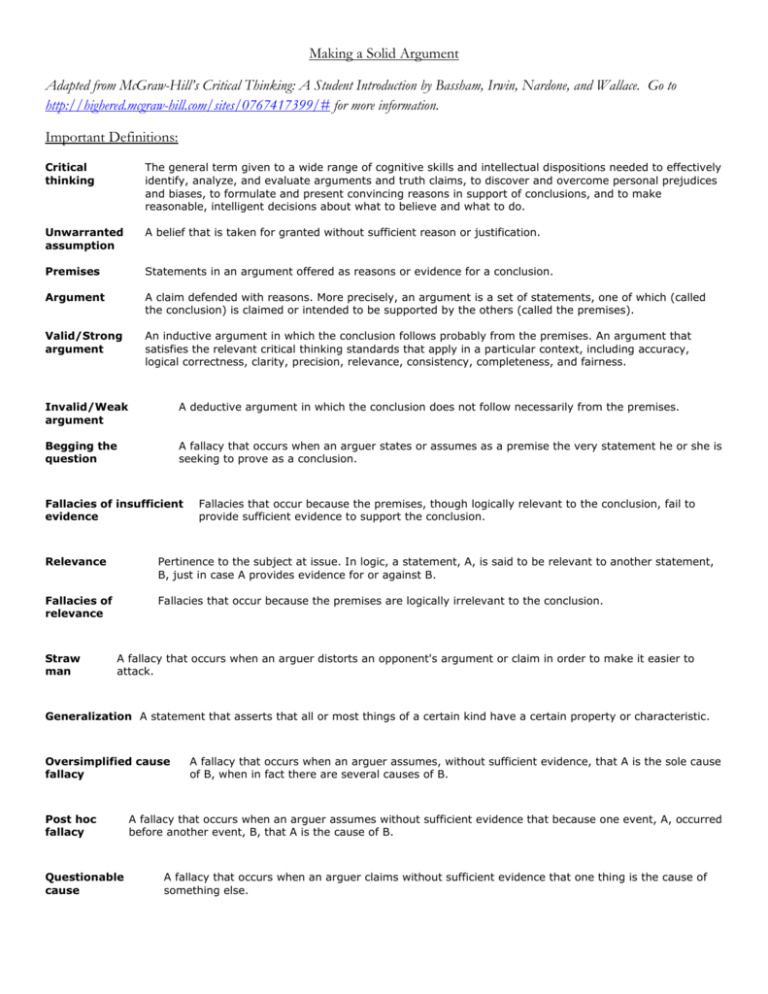
Making a Solid Argument Adapted from McGraw-Hill’s Critical Thinking: A Student Introduction by Bassham, Irwin, Nardone, and Wallace. Go to http://highered.mcgraw-hill.com/sites/0767417399/# for more information. Important Definitions: Critical thinking The general term given to a wide range of cognitive skills and intellectual dispositions needed to effectively identify, analyze, and evaluate arguments and truth claims, to discover and overcome personal prejudices and biases, to formulate and present convincing reasons in support of conclusions, and to make reasonable, intelligent decisions about what to believe and what to do. Unwarranted assumption A belief that is taken for granted without sufficient reason or justification. Premises Statements in an argument offered as reasons or evidence for a conclusion. Argument A claim defended with reasons. More precisely, an argument is a set of statements, one of which (called the conclusion) is claimed or intended to be supported by the others (called the premises). Valid/Strong argument An inductive argument in which the conclusion follows probably from the premises. An argument that satisfies the relevant critical thinking standards that apply in a particular context, including accuracy, logical correctness, clarity, precision, relevance, consistency, completeness, and fairness. Invalid/Weak argument A deductive argument in which the conclusion does not follow necessarily from the premises. Begging the question A fallacy that occurs when an arguer states or assumes as a premise the very statement he or she is seeking to prove as a conclusion. Fallacies of insufficient evidence Fallacies that occur because the premises, though logically relevant to the conclusion, fail to provide sufficient evidence to support the conclusion. Relevance Pertinence to the subject at issue. In logic, a statement, A, is said to be relevant to another statement, B, just in case A provides evidence for or against B. Fallacies of relevance Fallacies that occur because the premises are logically irrelevant to the conclusion. Straw man A fallacy that occurs when an arguer distorts an opponent's argument or claim in order to make it easier to attack. Generalization A statement that asserts that all or most things of a certain kind have a certain property or characteristic. Oversimplified cause fallacy Post hoc fallacy Questionable cause A fallacy that occurs when an arguer assumes, without sufficient evidence, that A is the sole cause of B, when in fact there are several causes of B. A fallacy that occurs when an arguer assumes without sufficient evidence that because one event, A, occurred before another event, B, that A is the cause of B. A fallacy that occurs when an arguer claims without sufficient evidence that one thing is the cause of something else. Characteristics of a good argument: 1. 2. 3. 4. 5. The premises are true and relevant to the conclusions that the argument comes to. The reasoning is correct and logical. There are no logical fallacies. The points are expressed clearly and precisely. All evidence given is clearly stated and linked to the argument being made. The link between the evidence and the conclusion is logical and explicitly stated. 6. The argument does not contradict other arguments in the paper. 7. All relevant evidence is taken into account. 8. The argument is fair to opposing arguments and views. What is wrong with these arguments? I know the Professor said that the Harry Potter was smarmy trash and lacked any artistic worth. But I still think he's wrong. After all, it was on the best-seller list for over 100 weeks. Capital punishment for repeatedly convicted drug dealers is absolutely justifiable because people who are found guilty of selling drugs again and again should be given the death penalty. Hey, I don't see what's wrong with taking a pad of paper or a few computer disks home from the office. I mean, they'll never be missed by anyone. Besides, this company has been underpaying me for years. Evaluating your own arguments: 1. Read what you have written and revise it, critically assessing the content of your paper from the perspective of a reader who may object to your views. 2. Consider what you have not written and revise your essay, critically evaluating any assumptions or evidence you have failed to examine carefully. 3. Show your work to others so as to receive critical comments from the perspective of a reader other than yourself. Make one good and one bad argument out of the given statements: 1. The number of tardies has decreased since the new tardy policy was implemented. Good: Bad: 2. A recent poll shows that Candidate A is beating Candidate B 52% to 48%. Good: Bad:



